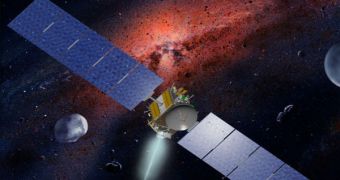On Tuesday, February 17th, NASA's spacecraft Dawn, which is currently heading for the asteroid belt with the aim of studying the Vesta asteroid and the Ceres dwarf planet, passed only 549 kilometers (341 miles) away from the Red Planet, thus successfully completing its Mars-assist stage. This maneuver, which required the craft to shut down it high-performance ion engine, saved NASA the difficulty of having to place an additional 230 pounds (104 kilograms) of xenon fuel in it, and also spared a lot of time.
When designing the plan for this mission, engineers at the American space agency understood that if the craft was to be sent on its own, it would have to carry a lot of fuel, which would have made it heavier and would have delayed its arrival significantly. They turned to Mars for help. Basically, their plan was to use the gravitational pull that Mars exerted naturally as a slingshot of sorts.
After Dawn passed the Red Planet, its thrusters were shut down, and the craft entered a dive towards the planet. But its trajectory was calculated so that it would only pass a short distance away from the Martian surface. Precise calculations were needed for this procedure, but apparently the team got it right, as proven by their latest success. Because the craft used the planet as a slingshot, it entered its pulling forces on one side, got swung around, and then exited its gravity on the other side, accomplishing two things at once.
First off, it accelerated considerably, which was a crucial part of the mission. Its speed increased by some 9,330 kilometers per hour (5,800 miles per hour), which meant that the amount of time it would spend in space until it reached its targets greatly diminished. Before the Mars-assist stage, its ion thrusters had already been working for 270 days.
Secondly, its orientation, as far as angles went, changed by more than 5 degrees, which set the spacecraft on the right path towards its target. In 2011, Dawn is scheduled to meet with and orbit Vesta, after which time it will move towards Ceres, which it will reach in 2015.
By that time, the probe would have already traveled approximately 4.8 billion kilometers, or 3 billion miles. In roughly 18 months, the craft will reach the first of the giant asteroids, and will begin to study it with its high-precision instruments. The missions on each of the two bodies will last a few months each.

 14 DAY TRIAL //
14 DAY TRIAL //